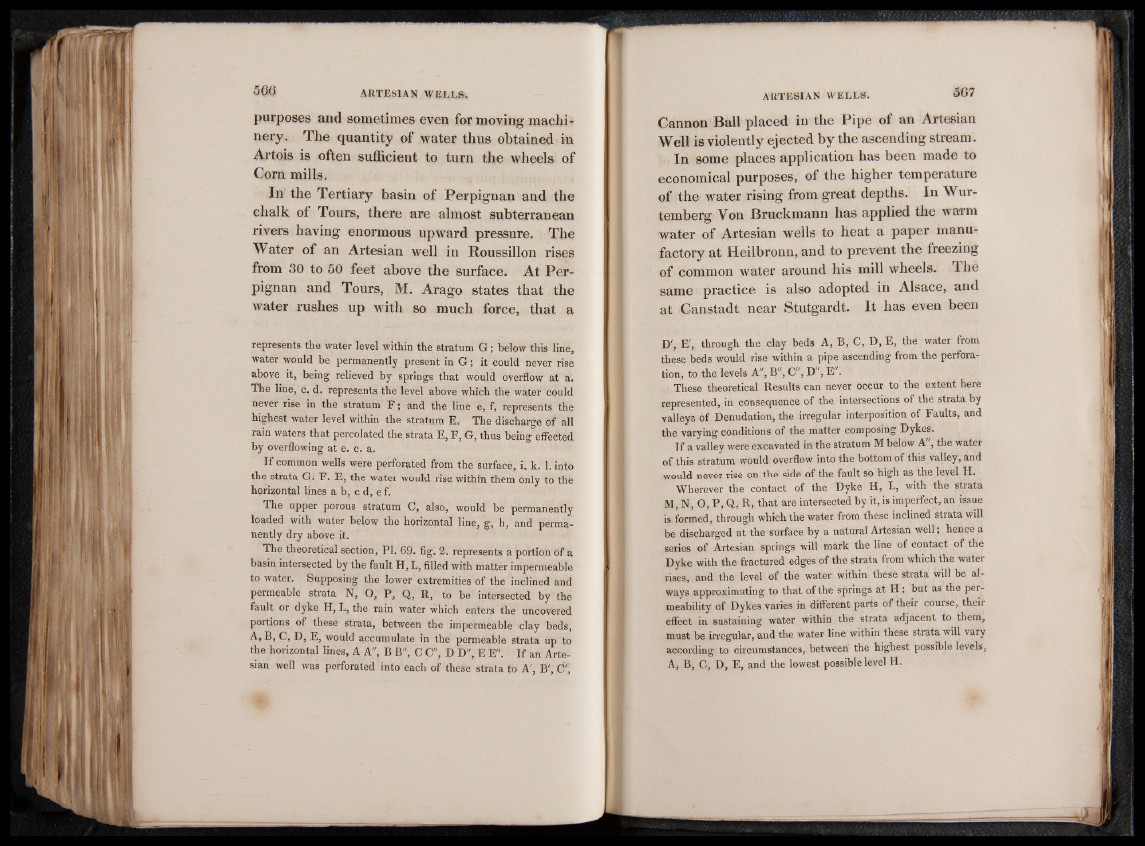
purposes and sometimes even for moving machinery.
The quantity of water thus obtained in
Artois is often sufficient to turn the wheels of
Corn mills.
In the Tertiary basin of Perpignan and the
chalk of Tours, there are almost subterranean
rivers having enormous upward pressure. The
Water of an Artesian well in Roussillon rises
from 30 to 50 feet above the surface. At Perpignan
and Tours, M. Arago states that the
water rushes up with so much force, that a
represents the water level within the stratum G ; below this line,
water would be permanently present in G ; it could never rise
above it, being relieved by springs that would overflow at a.
The line, c. d. represents the level above which the water could
never rise in the stratum F ; and the line e, f, represents the
highest water level within the stratum E. The discharge o f all
rain waters that percolated the strata E, F, G, thus being effected
by overflowing at e. c. a.
If common wells were perforated from the surface, i. k. 1. into
the strata G; F. E, the water would rise within them only to the
horizontal lines a b, c d, e f.
The upper porous stratum C, also, would be permanently
loaded with water below the horizontal line, g, h, and permanently
dry above it.
The theoretical section, PI. 69. fig. 2. represents a portion of a
basin intersected by the fault H, L, filled with matter impermeable
to water. Supposing the lower extremities of the inclined and
permeable strata N, O, P, Q, R, to be intersected by the
fault or dyke H, L, the rain water which enters the uncovered
portions of these strata, between the impermeable clay beds,
A, B, C, D, E, would accumulate in the permeable strata up to
the horizontal lines, A A", B B", C C", D D", E E". If an Artesian
well was perforated into each of these strata to A', B', C';
Cannon Ball placed in the Pipe of an Artesian
Well is violently ejected by the ascending stream.
In some places application has been made to
economical purposes, of the higher temperature
of the water rising from great depths. In Wur-
temberg Von Bruckmann has applied the warm
water of Artesian wells to heat a paper manufactory
at Heilbronn, and to prevent the freezing
of common water around his mill wheels. The
same practice is also adopted in Alsace, and
at Canstadt near Stutgardt. It has even been
D', E', through the clay beds A, B, C, D, E, the water from
these beds would rise within a pipe ascending from the perforation,
to the levels A", B", C", D", E".
These theoretical Results can never occur to the extent here
represented, in consequence of the intersections of the strata by
valleys of Denudation, the irregular interposition of Faults, and
the varying conditions of the matter composing Dykes.
If a valley were excavated in the stratum M below A", the water
of this stratum would overflow into the bottom of this valley, and
would never rise on the side of the fault so high as the level H.
Wherever the contact of the Dyke H, L, with the strata
M, N, O, P, Q, R, that are intersected by it, is imperfect, an issue
is formed, through which the water from these inclined strata will
be discharged at the surface by a natural Artesian well; hence a
series of Artesian springs will mark the line of contact of the
Dyke with the fractured edges of the strata from which the water
rises, and the level of the water within these strata will be always
approximating to that of the springs at H ; but as the pei-
meability of Dykes varies in different parts of their course, their
effect in sustaining water within the strata adjacent to them,
must be irregular, and the water line within these strata will vary
according to circumstances, between the highest possible levels,
A, B, C, D, E, and the lowest possible level H.